Characterization of human Spartan/C1orf124, an ubiquitin-PCNA interacting regulator of DNA damage tolerance
- PMID: 22987070
- PMCID: PMC3510514
- DOI: 10.1093/nar/gks850
Characterization of human Spartan/C1orf124, an ubiquitin-PCNA interacting regulator of DNA damage tolerance
Abstract
Unrepaired DNA damage may arrest ongoing replication forks, potentially resulting in fork collapse, increased mutagenesis and genomic instability. Replication through DNA lesions depends on mono- and polyubiquitylation of proliferating cell nuclear antigen (PCNA), which enable translesion synthesis (TLS) and template switching, respectively. A proper replication fork rescue is ensured by the dynamic ubiquitylation and deubiquitylation of PCNA; however, as yet, little is known about its regulation. Here, we show that human Spartan/C1orf124 protein provides a higher cellular level of ubiquitylated-PCNA by which it regulates the choice of DNA damage tolerance pathways. We find that Spartan is recruited to sites of replication stress, a process that depends on its PCNA- and ubiquitin-interacting domains and the RAD18 PCNA ubiquitin ligase. Preferential association of Spartan with ubiquitin-modified PCNA protects against PCNA deubiquitylation by ubiquitin-specific protease 1 and facilitates the access of a TLS polymerase to the replication fork. In concert, depletion of Spartan leads to increased sensitivity to DNA damaging agents and causes elevated levels of sister chromatid exchanges. We propose that Spartan promotes genomic stability by regulating the choice of rescue of stalled replication fork, whose mechanism includes its interaction with ubiquitin-conjugated PCNA and protection against PCNA deubiquitylation.
Figures
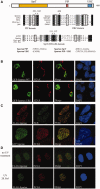
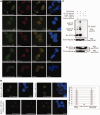
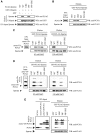
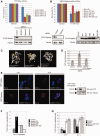
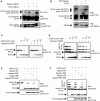
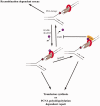
Similar articles
-
Spartan/C1orf124, a reader of PCNA ubiquitylation and a regulator of UV-induced DNA damage response.Mol Cell. 2012 Jun 8;46(5):625-35. doi: 10.1016/j.molcel.2012.05.020. Mol Cell. 2012. PMID: 22681887 Free PMC article.
-
Spartan/C1orf124 is important to prevent UV-induced mutagenesis.Cell Cycle. 2012 Sep 15;11(18):3395-402. doi: 10.4161/cc.21694. Epub 2012 Aug 16. Cell Cycle. 2012. PMID: 22894931 Free PMC article.
-
SPARTAN promotes genetic diversification of the immunoglobulin-variable gene locus in avian DT40 cells.DNA Repair (Amst). 2018 Aug;68:50-57. doi: 10.1016/j.dnarep.2018.06.003. Epub 2018 Jun 18. DNA Repair (Amst). 2018. PMID: 29935364
-
Dynamic regulation of PCNA ubiquitylation/deubiquitylation.FEBS Lett. 2011 Sep 16;585(18):2780-5. doi: 10.1016/j.febslet.2011.05.053. Epub 2011 Jun 1. FEBS Lett. 2011. PMID: 21640107 Free PMC article. Review.
-
Regulation of DNA damage tolerance in mammalian cells by post-translational modifications of PCNA.Mutat Res. 2017 Oct;803-805:82-88. doi: 10.1016/j.mrfmmm.2017.06.004. Epub 2017 Jun 21. Mutat Res. 2017. PMID: 28666590 Review.
Cited by
-
Regulation of PCNA-protein interactions for genome stability.Nat Rev Mol Cell Biol. 2013 May;14(5):269-82. doi: 10.1038/nrm3562. Epub 2013 Apr 18. Nat Rev Mol Cell Biol. 2013. PMID: 23594953 Review.
-
Mechanisms of damage tolerance and repair during DNA replication.Nucleic Acids Res. 2021 Apr 6;49(6):3033-3047. doi: 10.1093/nar/gkab101. Nucleic Acids Res. 2021. PMID: 33693881 Free PMC article. Review.
-
PRP19 transforms into a sensor of RPA-ssDNA after DNA damage and drives ATR activation via a ubiquitin-mediated circuitry.Mol Cell. 2014 Jan 23;53(2):235-246. doi: 10.1016/j.molcel.2013.11.002. Epub 2013 Dec 12. Mol Cell. 2014. PMID: 24332808 Free PMC article.
-
USP11 mediates repair of DNA-protein cross-links by deubiquitinating SPRTN metalloprotease.J Biol Chem. 2021 Jan-Jun;296:100396. doi: 10.1016/j.jbc.2021.100396. Epub 2021 Feb 7. J Biol Chem. 2021. PMID: 33567341 Free PMC article.
-
Quantification of Intracellular DNA-Protein Cross-Links with N7-Methyl-2'-Deoxyguanosine and Their Contribution to Cytotoxicity.Chem Res Toxicol. 2024 May 20;37(5):814-823. doi: 10.1021/acs.chemrestox.4c00076. Epub 2024 Apr 23. Chem Res Toxicol. 2024. PMID: 38652696 Free PMC article.
References
-
- Prakash S, Johnson RE, Prakash L. Eukaryotic translesion synthesis DNA polymerases: specificity of structure and function. Annu. Rev. Biochem. 2005;74:317–353. - PubMed
-
- Bailly V, Lamb J, Sung P, Prakash S, Prakash L. Specific complex-formation between yeast Rad6 and Rad18 proteins—a potential mechanism for targeting Rad6 ubiquitin-conjugating activity to DNA-damage sites. Genes Dev. 1994;8:811–820. - PubMed
-
- Prakash S, Prakash L. Translesion DNA synthesis in eukaryotes: a one- or two-polymerase affair. Genes Dev. 2002;16:1872–1883. - PubMed
Publication types
MeSH terms
Substances
Grants and funding
LinkOut - more resources
Full Text Sources
Other Literature Sources
Molecular Biology Databases
Research Materials
Miscellaneous

